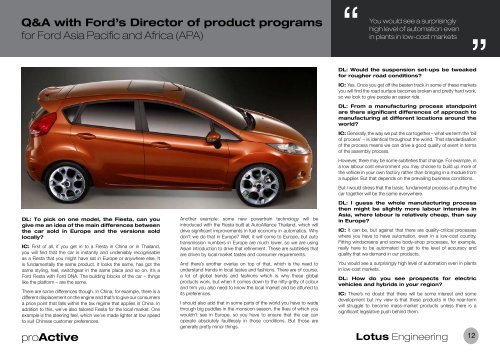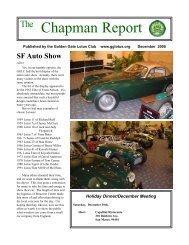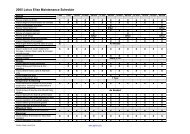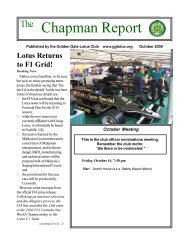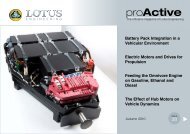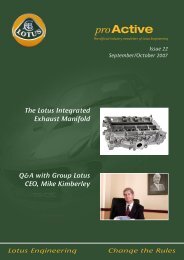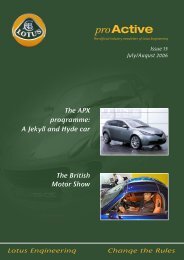Pro Active
Pro Active
Pro Active
You also want an ePaper? Increase the reach of your titles
YUMPU automatically turns print PDFs into web optimized ePapers that Google loves.
Q&A with Ford’s Director of product programs<br />
for Ford Asia Pacific and Africa (APA)<br />
DL: To pick on one model, the Fiesta, can you<br />
give me an idea of the main differences between<br />
the car sold in Europe and the versions sold<br />
locally?<br />
IC: First of all, if you get in to a Fiesta in China or in Thailand,<br />
you will find that the car is instantly and undeniably recognisable<br />
as a Fiesta that you might have sat in Europe or anywhere else. It<br />
is fundamentally the same product. It looks the same, has got the<br />
same styling, feel, switchgear in the same place and so on. It’s a<br />
Ford Fiesta with Ford DNA. The building blocks of the car – things<br />
like the platform – are the same.<br />
There are some differences though. In China, for example, there is a<br />
different displacement on the engine and that’s to give our consumers<br />
a price point that falls within the tax regime that applies in China. In<br />
addition to this, we’ve also tailored Fiesta for the local market. One<br />
example is the steering feel, which we’ve made lighter at low speed<br />
to suit Chinese customer preferences.<br />
pro<strong>Active</strong><br />
Another example: some new powertrain technology will be<br />
introduced with the Fiesta built at AutoAlliance Thailand, which will<br />
drive significant improvements in fuel economy in automatics. Why<br />
don’t we do that in Europe? Well, it will come to Europe, but auto<br />
transmission numbers in Europe are much lower, so we are using<br />
Asian introduction to drive that refinement. These are subtleties that<br />
are driven by local market tastes and consumer requirements.<br />
And there’s another overlay on top of that, which is the need to<br />
understand trends in local tastes and fashions. There are of course,<br />
a lot of global trends and fashions which is why these global<br />
products work, but when it comes down to the nitty-gritty of colour<br />
and trim you also need to know the local market and be attuned to<br />
its preferences.<br />
I should also add that in some parts of the world you have to wade<br />
through big puddles in the monsoon season, the likes of which you<br />
wouldn’t see in Europe, so you have to ensure that the car can<br />
operate absolutely faultlessly in those conditions. But those are<br />
generally pretty minor things.<br />
“<br />
You would see a surprisingly<br />
high level of automation even<br />
in plants in low-cost markets<br />
DL: Would the suspension set-ups be tweaked<br />
for rougher road conditions?<br />
IC: Yes. Once you get off the beaten track in some of these markets<br />
you will find the road surface becomes broken and pretty hard work,<br />
so we look to give people an easier ride.<br />
DL: From a manufacturing process standpoint<br />
are there significant differences of approach to<br />
manufacturing at different locations around the<br />
world?<br />
IC: Generally, the way we put the car together – what we term the ‘bill<br />
of process’ – is identical throughout the world. That standardisation<br />
of the process means we can drive a good quality of event in terms<br />
of the assembly process.<br />
However, there may be some subtleties that change. For example, in<br />
a low labour cost environment you may choose to build up more of<br />
the vehicle in your own factory rather than bringing in a module from<br />
a supplier. But that depends on the prevailing business conditions.<br />
But I would stress that the basic, fundamental process of putting the<br />
car together will be the same everywhere.<br />
DL: I guess the whole manufacturing process<br />
then might be slightly more labour intensive in<br />
Asia, where labour is relatively cheap, than say<br />
in Europe?<br />
IC: It can be, but against that there are quality-critical processes<br />
where you have to have automation, even in a low-cost country.<br />
Fitting windscreens and some body-shop processes, for example,<br />
really have to be automated to get to the level of accuracy and<br />
quality that we demand in our products.<br />
You would see a surprisingly high level of automation even in plants<br />
in low-cost markets.<br />
DL: How do you see prospects for electric<br />
vehicles and hybrids in your region?<br />
IC: There’s no doubt that there will be some interest and some<br />
development but my view is that these products in the near-term<br />
will struggle to become mass-market products unless there is a<br />
significant legislative push behind them.<br />
Lotus Engineering<br />
”<br />
12


